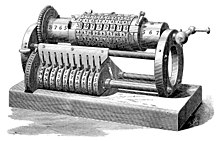George B. Grant
George Barnard Grant (December 21, 1849 – August 16, 1917) was an American mechanical engineer, inventor, entrepreneur and
Personal life
Grant was born in Gardiner, Maine, to Peter Grant, a farmer, and Vesta (Capen) Grant.
After graduation from Harvard, Grant lived in Boston and Maplewood, Massachusetts. He moved to Lexington, Massachusetts, in 1887, and then Pasadena, California, around 1900. He died in Pasadena in 1917, having never married.[4]


Calculating machine work
While a student at Harvard, Grant worked on the problem of inventing a mechanical calculator. With the encouragement of his professor,
Gear industry work
As an outgrowth of Grant's work on calculating machines, he became interested in the production of gears. This field was undergoing much growth and change in the late 19th century. Grant played a leading role in that development. For example, a controversy had raged for many years over gears' optimal design. In Grant's time, the most common were
Contributions to botany
In California, starting in about 1900, Grant became a collector of previously undocumented plant species. He named a number of plants, and his collection is now part of the Stanford University herbarium.[15][16]
Publications
- Grant, George B. (June 5, 1871). "On a New Difference Engine". American Journal of Science and Arts. 2 (8): 113–117. S2CID 131553703.
- Grant, George B. (July 15, 1874). "A New Calculating Machine". American Journal of Science and Arts. 8 (46): 277–284. S2CID 131309896.
- Grant, George B. (1885). A Handbook on the Teeth of Gears. Lexington Gear Works.
- Grant, George B. (1891). Odontics: Or, The Theory and Practice of the Teeth of Gears. Lexington, MA: Lexington Gear Works.
- Grant, George B. (1899). A Treatise on Gear Wheels. Philadelphia Gear Works.
Patents
- U.S. patent 129,335, "Improvement in Calculating-Machines", 1872[17]
- U.S. patent 138,245, "Improvement in Calculating-Machines", 1873[18]
- U.S. patent 368,528 "Calculating-Machine" from 1887[19]
- U.S. patent 405,030 "Machine for Cutting Spur and Worm Gears", 1889[20]
- U.S. patent 407,437 "Machine for Planing Gear Teeth", 1889[21]
- U.S. patent 512,189 "Machine for Generating Beveled Gear-Teeth", 1894[22]
- U.S. patent 605,288 "Calculating-Machine", 1898[23]
Further reading
- G.B. Grant obituary, August 18, 1917, Boston Evening Transcript
- Otnes, Robert K. (1987) Calculators by George B. Grant. Historische Buerowelt
- Merzbach, Uta C.; Zoology, Smithsonian Contributions To; Ripley, S. Dillon; Merzbach, Uta C. (1977). Georg Scheutz and the First Printing Calculator. CiteSeerX 10.1.1.639.3286.
- Woodbury, Robert C. (1972) "Studies in the History of Machine Tools", The M.I.T. Press
References
- ^ L. Leland Locke, "George Barnard Grant", Dictionary of American Biography, vol. 7, New York: Scribners, 1931, pp. 487–488y
- ^ Rugged Gear Man Grant, American Machinist, August 28, 1947
- ^ "Our Family Genealogy Pages – George Barnard Grant". OurFamilyTree.com. Retrieved November 18, 2017.
- ^ Grant, George (1928–1936). Dictionary of American Biography. American Council of Learned Societies.
- S2CID 131553703.
- ^ Sandhurst, Phillip K. (1876). The Centennial Exhibition Critically Described And Illustrated. P.W. Ziegler & Co.
- ^ Grant, George (January 23, 2003). "Grant Calculating Machine". IBM Archives. IBM. Retrieved November 18, 2017.
- ^ Grant, George. "Grant Calculating Machine, Centennial Model". National Museum of American History. Smithsonian. Retrieved November 18, 2017.
- ^ "Collections Search Result: George B. Grant". Smithsonian Institution. Retrieved November 15, 2017.
- ^ Locke, L. Leland (1931). George Barnard Grant, Dictionary of American Biography. American Council of Learned Societies.
- .
- ISBN 9780262730334.
- ^ "Company Website". Boston Gear Works. Retrieved November 22, 2017.
- ^ Power Transmission and Gearing Solutions - Philadelphia Gear
- ^ [herbarium "Grant, George Bernard"]. Islapedia. Retrieved November 22, 2017.
{{cite web}}: Check|url=value (help) - ^ "G.B. Grant". International Plant Name Index. Retrieved November 22, 2017.
- ^ Grant, George. "Improvement in Calculating-Machines". U.S. Patent and Trademark Database. U.S.Patent and Trademark Office. Retrieved November 21, 2017.
- ^ Grant, George. "US Patent 138,245". U.S. Patent and Trademark Database. U.S. Patent and Trademark Office. Retrieved November 18, 2017.
- ^ Grant, George. "Calculating-Machine". U.S. Patent and Trademark Database. U.S. Patent and Trademark Office. Retrieved November 18, 2017.
- ^ Grant, George. "Machine for Cutting Spur and Worm Gears". U.S. Patent and Trademark Database. U.S. Patent and Trademark Office. Retrieved November 18, 2017.
- ^ Grant, George. "Patent for Machine for Planing Gear Teeth". U.S. Patent and Trademark Database. U.S. Patent and Trademark Office. Retrieved November 18, 2017.
- ^ Grant, George. "Machine for Generating Beveled Gear Teeth". U.S. Patent and Trademark Database. U.S. Patent and Trademark Office. Retrieved November 18, 2017.
- ^ Grant, George. "Calculating-Machine". U.S. Patent and Trademark Database. U.S. Patent and Trademark Office. Retrieved November 18, 2017.
